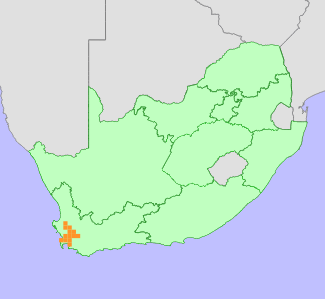|
Scientific Name | Hesperantha spicata (Burm.f.) N.E.Br. subsp. spicata |
Higher Classification | Monocotyledons |
Family | IRIDACEAE |
Synonyms | Ixia spicata Burm.f. |
Common Names | Aandkaneelblom (a), Avondbloem-caneelbloem (a), Kaneelaandblom (a), Kaneelpypie (a), Kaneeltjie (a) |
National Status |
Status and Criteria | Near Threatened B1ab(ii,iii,v)+2ab(ii,iii,v) |
Assessment Date | 2023/08/23 |
Assessor(s) | D. Raimondo, N.A. Helme & T. Patel |
Justification | This subspecies has an extent of occurrence (EOO) of 7255 km², and an area of occupancy (AOO) of 104 km². It is known from 10-15 locations. Its habitat is severely fragmented due to crop cultivation and urban development. Competition from invasive alien plants further threatens this species. With the population declining but with more than 10 locations extant, it almost reaches the thresholds for listing as Vulnerable under criterion B and is assessed as Near Threatened. |
Distribution |
Endemism | South African endemic |
Provincial distribution | Western Cape |
Range | It is endemic to South Africa and extends from the lower slopes of the Piketberg to the Tulbagh Valley and the northern Cape Peninsula. |
Habitat and Ecology |
Major system | Terrestrial |
Major habitats | Swartland Shale Renosterveld, Breede Shale Renosterveld, Peninsula Shale Renosterveld, Swartland Silcrete Renosterveld, Swartland Alluvium Fynbos, Breede Alluvium Fynbos |
Description | It usually occurs on stony clay or clay loam. |
Threats |
| This subspecies has lost 73% of its habitat (calculated using landcover data in GIS). It is under threat from crop cultivation, wheat and vineyard farming, urban development around Cape Town and Gordon's Bay, and invasive alien grasses. |
Population |
It is known from 10-15 extant subpopulations. The population is decreasing and faces a number of ongoing threats. The largest recorded subpopulation is in Briers Louw Nature Reserve, where between 250 and 500 plants were observed in 2015. Less than 50 plants were reported in 2011 at Klipheuwel. Less than 10 have been observed in the following subpopulations over the last few years: Malmesbury (2015), Joostenbergkloof (2015), Klipheuwel (2012), and Hercules Pilaar (2012). Goldblatt and Manning (2020), however, note that this species is common after fire, and hence we assume that monitoring records are from non-fire years and may underestimate the actual sizes of subpopulations. One subpopulation has gone extinct in Kenilworth, Cape Town.
|
Population trend | Decreasing |
Assessment History |
Taxon assessed |
Status and Criteria |
Citation/Red List version | | Hesperantha spicata (Burm.f.) N.E.Br. subsp. spicata | VU B1ab(ii,iii,iv,v) | Raimondo et al. (2009) | |
Bibliography |
Goldblatt, P. 1984. A revision of Hesperantha (Iridaceae) in the winter rainfall area of southern Africa. Journal of South African Botany 50:14-141.
Goldblatt, P. and Manning, J.C. 2000. Cape Plants: A conspectus of the Cape Flora of South Africa. Strelitzia 9. National Botanical Institute, Cape Town.
Goldblatt, P. and Manning, J.C. 2020. Iridaceae of southern Africa. Strelitzia 42. South African National Biodiversity Institute, Pretoria.
Raimondo, D., von Staden, L., Foden, W., Victor, J.E., Helme, N.A., Turner, R.C., Kamundi, D.A. and Manyama, P.A. 2009. Red List of South African Plants. Strelitzia 25. South African National Biodiversity Institute, Pretoria.
|
Citation |
| Raimondo, D., Helme, N.A. & Patel, T. 2023. Hesperantha spicata (Burm.f.) N.E.Br. subsp. spicata. National Assessment: Red List of South African Plants version 2024.1. Accessed on 2025/11/20 |
 Comment on this assessment
Comment on this assessment

